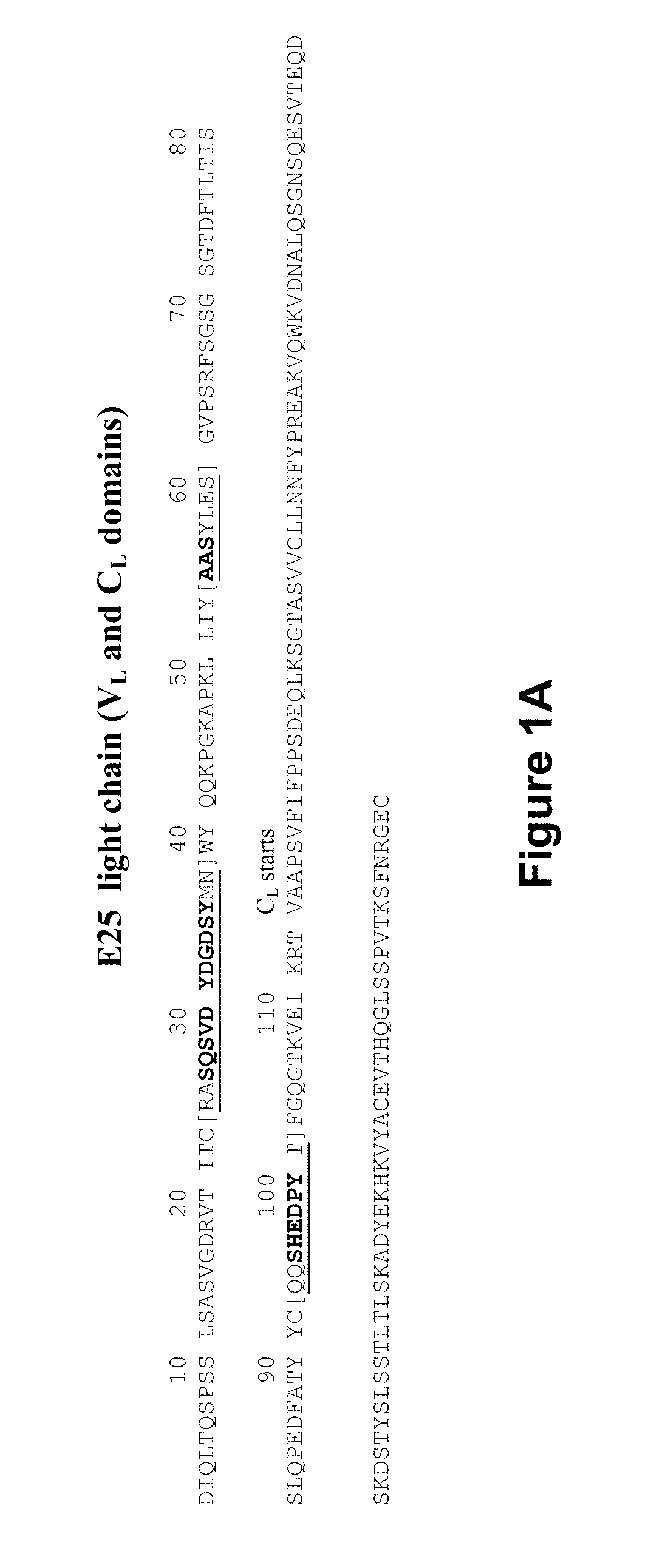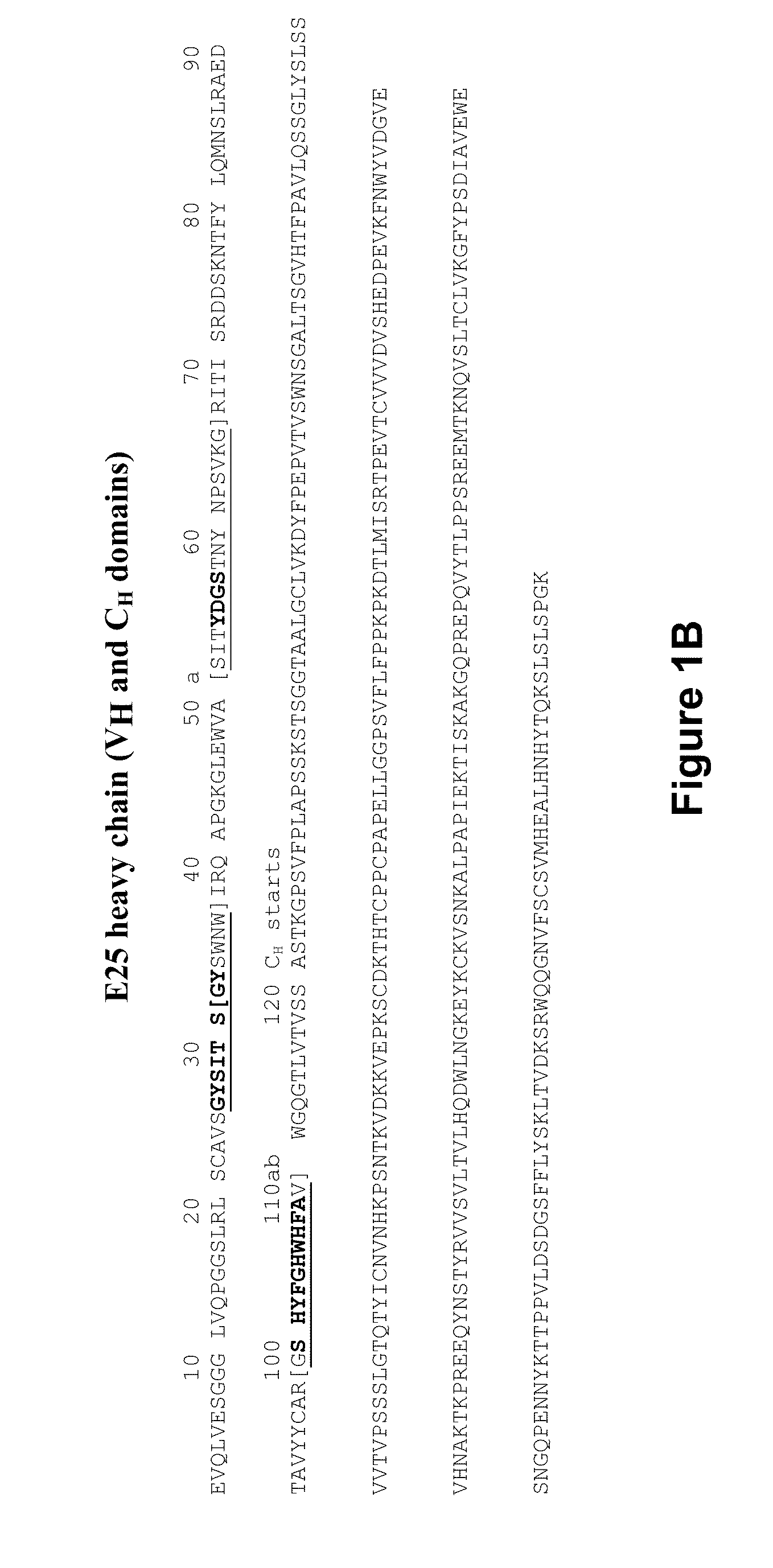Assays for detecting antibodies specific to therapeutic Anti-ige antibodies and their use in anaphylaxis
a technology of anti-ige antibodies and antibodies, applied in the field of antibodies specific to therapeutic anti-ige antibodies and their use in anaphylaxis, can solve the problems of serious cases and potentially life-threatening, and achieve the effect of reducing the relative binding affinity of mutant therapeutic antibodies to human ig
- Summary
- Abstract
- Description
- Claims
- Application Information
AI Technical Summary
Benefits of technology
Problems solved by technology
Method used
Image
Examples
example 1
Preparation of a Mutant Antibody from Anti-IgE Antibody Omalizumab
[0222]The antibody omalizumab (E25 or rhuMAbE25) is a humanized anti-human IgE antibody described in U.S. Pub. No. 2005 / 0158303 and U.S. Pat. No. 6,172,213. The amino acid sequences of the heavy and light chain variable region of E25 are provided in FIG. 2 in U.S. Pat. No. 6,172,213, and the amino acid sequences of the full length heavy and light chain of E25 are provided in FIG. 12 in U.S. Pat. No. 6,172,213. The heavy chain and light chain amino acid sequences of antibody E25 are shown in FIGS. 1A and 1B. A mutant E25, referred to as E25-AAA mutant, containing three amino acid substitutions in the light chain CDR1 was generated. The mutations are substitutions from D to A at positions 30, 32, 34 shown in SEQ ID NO:1. This mutant antibody is described in Presta et al., J. Immunol. 151:2623-2632, 1993.
[0223]The binding affinity of this mutant antibody to human IgE relative to E25 was tested as shown in FIG. 2A. E25 or...
example 2
Comparison of Binding of Anti-Drug Antibodies to E25 and E25-AAA Mutant
[0226]Murine monoclonal antibodies specific to E25 were generated. As shown in Table 2 below, AME1, AME7, AME9, AME2, AME10, AME13, AME4, and AME5 are antibodies that bind to E25. AME1, AME7, AME9, AME2, AME10, AME4, and AME5 are mouse IgG1, and AME13 is a mouse IgG2 antibody. E25 is a humanized antibody derived from MAE11 as described in Example 1 and in Presta et al., J. Immunol. 151:2623-2632, 1993. MAE1 is a control anti-human IgE monoclonal antibody, and has different CDRs from MAE11. MAE 1 and MAE11 are mouse IgG antibodies. Control antibody (full length) is an IgG antibody with framework residues similar to E25, but binds a different antigen. Negative binding to MAE1 demonstrated that AMEs were specific to E25 sequences only. To test whether these anti-drug antibodies bind equally well to E25 and E25-AAA mutant, binding assays were carried out using methods known in the art. See, e.g., Engvall et al., Immu...
example 3
Preparation of an E25-Specific IgE Positive Control Antibody
[0227]FIG. 5 shows a positive control antibody that may be used in the assay system described herein. This antibody has the heavy and light chain variable regions from AME2 and constant regions from a human IgE.
[0228]The positive control antibody was tested using an assay shown in FIG. 6A. The surface of an ELISA plate was coated with human FcεRIα IgG chimeric receptor. E25-specific IgE positive control antibody was added to the plate and incubated to allow binding to the immobilized receptor. Either E25 or E25-AAA mutant with increasing concentration was added to the plate and incubated to allow binding of E25 or E25-AAA mutant. Binding of E25 or E25-AAA mutant to the plate was measured using HRP-anti-human IgG antibody. The results are shown in FIG. 6B. The experiment indicates that the positive control antibody shown in FIG. 3 binds equally well to E25 and E25-AAA mutant and may be used in the assay system described here...
PUM
 Login to View More
Login to View More Abstract
Description
Claims
Application Information
 Login to View More
Login to View More - R&D
- Intellectual Property
- Life Sciences
- Materials
- Tech Scout
- Unparalleled Data Quality
- Higher Quality Content
- 60% Fewer Hallucinations
Browse by: Latest US Patents, China's latest patents, Technical Efficacy Thesaurus, Application Domain, Technology Topic, Popular Technical Reports.
© 2025 PatSnap. All rights reserved.Legal|Privacy policy|Modern Slavery Act Transparency Statement|Sitemap|About US| Contact US: help@patsnap.com



